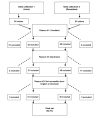COVID-19 and Vitamin D Misinformation on YouTube: Content Analysis
- PMID: 35310014
- PMCID: PMC8924908
- DOI: 10.2196/32452
COVID-19 and Vitamin D Misinformation on YouTube: Content Analysis
Abstract
Background: The "infodemic" accompanying the SARS-CoV-2 virus pandemic has the potential to increase avoidable spread as well as engagement in risky health behaviors. Although social media platforms, such as YouTube, can be an inexpensive and effective method of sharing accurate health information, inaccurate and misleading information shared on YouTube can be dangerous for viewers. The confusing nature of data and claims surrounding the benefits of vitamin D, particularly in the prevention or cure of COVID-19, influences both viewers and the general "immune boosting" commercial interest.
Objective: The aim of this study was to ascertain how information on vitamin D and COVID-19 was presented on YouTube in 2020.
Methods: YouTube video results for the search terms "COVID," "coronavirus," and "vitamin D" were collected and analyzed for content themes and deemed useful or misleading based on the accuracy or inaccuracy of the content. Qualitative content analysis and simple statistical analysis were used to determine the prevalence and frequency of concerning content, such as confusing correlation with causation regarding vitamin D benefits.
Results: In total, 77 videos with a combined 10,225,763 views (at the time of data collection) were included in the analysis, with over three-quarters of them containing misleading content about COVID-19 and vitamin D. In addition, 45 (58%) of the 77 videos confused the relationship between vitamin D and COVID-19, with 46 (85%) of 54 videos stating that vitamin D has preventative or curative abilities. The major contributors to these videos were medical professionals with YouTube accounts. Vitamin D recommendations that do not align with the current literature were frequently suggested, including taking supplementation higher than the recommended safe dosage or seeking intentional solar UV radiation exposure.
Conclusions: The spread of misinformation is particularly alarming when spread by medical professionals, and existing data suggesting vitamin D has immune-boosting abilities can add to viewer confusion or mistrust in health information. Further, the suggestions made in the videos may increase the risks of other poor health outcomes, such as skin cancer from solar UV radiation.
Keywords: COVID-19; YouTube; content analysis; health information; immune system; immunity; infodemic; misinformation; natural medicine; prevention; risk; social media; supplements; video; vitamin D.
©Emma K Quinn, Shelby Fenton, Chelsea A Ford-Sahibzada, Andrew Harper, Alessandro R Marcon, Timothy Caulfield, Sajjad S Fazel, Cheryl E Peters. Originally published in JMIR Infodemiology (https://infodemiology.jmir.org), 14.03.2022.
Conflict of interest statement
Conflicts of Interest: None declared.
Figures
Similar articles
-
Evaluation of Korean-Language COVID-19-Related Medical Information on YouTube: Cross-Sectional Infodemiology Study.J Med Internet Res. 2020 Aug 12;22(8):e20775. doi: 10.2196/20775. J Med Internet Res. 2020. PMID: 32730221 Free PMC article.
-
YouTube: Is It a Reliable Source of Nutrition Information on COVID-19 Pandemic?Healthcare (Basel). 2022 Sep 29;10(10):1911. doi: 10.3390/healthcare10101911. Healthcare (Basel). 2022. PMID: 36292358 Free PMC article.
-
YouTube as a source of information on COVID-19: a pandemic of misinformation?BMJ Glob Health. 2020 May;5(5):e002604. doi: 10.1136/bmjgh-2020-002604. BMJ Glob Health. 2020. PMID: 32409327 Free PMC article.
-
Information Seeking in Social Media: A Review of YouTube for Sedentary Behavior Content.Interact J Med Res. 2015 Jan 20;4(1):e3. doi: 10.2196/ijmr.3835. Interact J Med Res. 2015. PMID: 25604433 Free PMC article. Review.
-
Literature review on risky driving videos on YouTube: Unknown effects and areas for concern?Traffic Inj Prev. 2017 Aug 18;18(6):606-615. doi: 10.1080/15389588.2016.1276575. Epub 2017 Jan 24. Traffic Inj Prev. 2017. PMID: 28118026 Review.
Cited by
-
Vitamin D Supplementation During COVID-19 Lockdown and After 20 Months: Follow-Up Study on Slovenian Women Aged Between 44 and 66.Zdr Varst. 2023 Oct 4;62(4):182-189. doi: 10.2478/sjph-2023-0026. eCollection 2023 Dec. Zdr Varst. 2023. PMID: 37799414 Free PMC article.
-
Mapping automatic social media information disorder. The role of bots and AI in spreading misleading information in society.PLoS One. 2024 May 31;19(5):e0303183. doi: 10.1371/journal.pone.0303183. eCollection 2024. PLoS One. 2024. PMID: 38820281 Free PMC article.
-
Rise in Serum 25-Hydroxyvitamin D Levels during the COVID-19 Pandemic.Nutrients. 2024 Jul 27;16(15):2449. doi: 10.3390/nu16152449. Nutrients. 2024. PMID: 39125330 Free PMC article.
-
Unlocking insights: Navigating COVID-19 challenges and Emulating future pandemic Resilience strategies with strengthening natural immunity.Heliyon. 2024 Jul 17;10(15):e34691. doi: 10.1016/j.heliyon.2024.e34691. eCollection 2024 Aug 15. Heliyon. 2024. PMID: 39166024 Free PMC article. Review.
-
Anti-masking Posts on Instagram: Content Analysis During the COVID-19 Pandemic.Saf Health Work. 2025 Mar;16(1):27-35. doi: 10.1016/j.shaw.2024.11.002. Epub 2024 Nov 14. Saf Health Work. 2025. PMID: 40176930 Free PMC article.
References
-
- Coronavirus Disease (COVID-19) Pandemic. World Health Organization. [2022-02-11]. https://www.who.int/emergencies/diseases/novel-coronavirus-2019 .
-
- Bradshaw S, Howard P. The Global Disinformation Order: 2019 Global Inventory of Organised Social Media Manipulation. University of Oxford. [2022-02-11]. https://comprop.oii.ox.ac.uk/wp-content/uploads/sites/93/2019/09/CyberTr... .
-
- Bavel JJV, Baicker K, Boggio PS, Capraro V, Cichocka A, Cikara M, Crockett MJ, Crum AJ, Douglas KM, Druckman JN, Drury J, Dube O, Ellemers N, Finkel EJ, Fowler JH, Gelfand M, Han S, Haslam SA, Jetten J, Kitayama S, Mobbs D, Napper LE, Packer DJ, Pennycook G, Peters E, Petty RE, Rand DG, Reicher SD, Schnall S, Shariff A, Skitka LJ, Smith SS, Sunstein CR, Tabri N, Tucker JA, Linden SVD, Lange PV, Weeden KA, Wohl MJA, Zaki J, Zion SR, Willer R. Using social and behavioural science to support COVID-19 pandemic response. Nat Hum Behav. 2020 May 30;4(5):460–471. doi: 10.1038/s41562-020-0884-z.10.1038/s41562-020-0884-z - DOI - PubMed
-
- Kemp S. TikTok Hits 1 Billion Users? Faster Than Facebook (And More New Stats) Hootsuite. [2022-02-11]. https://blog.hootsuite.com/simon-kemp-social-media/
-
- Busari S, Adebayo B. Nigeria Records Chloroquine Poisoning after Trump Endorses It for Coronavirus Treatment. CNN. [2022-02-11]. https://edition.cnn.com/2020/03/23/africa/chloroquine-trump-nigeria-intl... .
LinkOut - more resources
Full Text Sources
Miscellaneous





